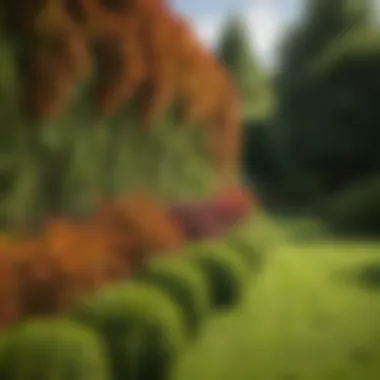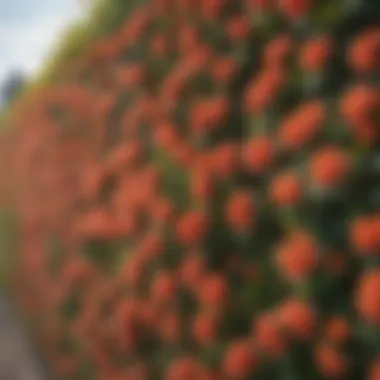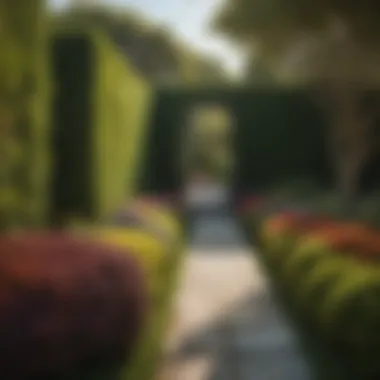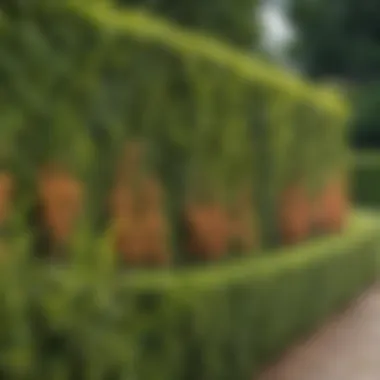The Aesthetic and Functional Appeal of Colorful Hedges


Intro
Colorful hedges play a significant role in outdoor environments. They merge aesthetic appeal with practical use. This article explores how these natural barriers enhance spaces while providing suggestions for maintenance and design.
By understanding the various hedge types and their functions, readers can make informed decisions about their landscaping choices. This guide aims to inspire those invested in luxury outdoor living, including landscape architects and high-end event planners.
Outdoor Decor Ideas
Colorful hedges can dramatically elevate outdoor decor. They provide vibrant backdrops and can define areas within a landscape. This section discusses various ways to incorporate hedges into outdoor design.
Seasonal Inspirations
Different seasons highlight various aspects of color in hedges.
- Spring brings lush greens and bright blooms.
- Summer showcases strong foliage colors.
- Autumn offers deep reds, oranges, and yellows.
- Winter shows the structure of hedges against snow backdrops.
Using seasonal color, designers can plan outdoor spaces that shine throughout the year.
Furniture Selection
Selecting outdoor furniture can enhance the presence of colorful hedges.
- Choose neutral tones for furniture to avoid clashing with hedge colors.
- Materials like teak or aluminum complement the natural elements.
- Consider cushions and textiles that add color but remain harmonized with the landscape.
This combination creates a balance between natural and manufactured beauty.
Decorative Lighting
Lighting accentuates hedges at night, offering them a new life.
- String lights can add whimsy and intimacy to a space.
- Spotlights can draw attention to particularly stunning hedge varieties.
- Solar lanterns provide eco-friendly options that blend seamlessly.
Carefully placed illumination enhances both aesthetics and usability of outdoor areas.
Plant Arrangements
Hedges can serve as a foundation for other plants.
Arranging small shrubs or flowers around hedges can create depth and interest.
Consider layering:
- Plant tall flowers in the back.
- Use medium shrubs as a middle layer.
- Include low-growing plants in the front.
This method produces a visually appealing tapestry of colors and textures.
Hardscaping Solutions
Integrating hedges with hardscape elements enhances functionality.
- Pathways can be lined with low hedges for separation.
- Stone walls serve as backdrops for taller hedges.
- Patios can feature hedges for privacy and shade.
These choices create a cohesive outdoor experience that links natural and built environments.
Sustainable Practices
Opting for sustainable hedge varieties benefits the environment.
- Choose native species that require less maintenance.
- Incorporate drip irrigation systems for water efficiency.
- Use organic mulch to reduce weeds and retain moisture.
Applying these practices is essential for luxury outdoor spaces that respect ecological balance.
Preamble to Colorful Hedges
Colorful hedges represent an intersection of beauty and functionality in outdoor spaces. They are not only a visual delight but serve numerous practical purposes. Understanding their significance sets the stage for a deeper exploration into their aesthetic and functional dimensions.
In this article, we will detail how colorful hedges can transform landscapes, providing various benefits from enhancing privacy to attracting wildlife. These elements appeal to homeowners, landscape designers, and architects alike, all looking to elevate outdoor experiences. Considerations around choosing the right species, placement, and maintenance will also be discussed to ensure sustainable growth and longevity.
Defining Colorful Hedges
Colorful hedges can be defined as boundaries or barriers formed by various shrubs and plants that exhibit vibrant colors through their foliage, blossoms, or both. They serve as a living palette that offers aesthetic interest year-round. Deciduous hedges may boast brilliant hues in autumn, while evergreens provide a consistent backdrop.
These features not only enhance the visual appeal of gardens but can also delineate space artistically. Examples include Boxwood, with its lush green leaves, or flowering varieties like Lilac, showcasing shades of purple. The choice of species can dramatically alter the initial perception of any landscape.
Historical Context
The use of hedges for aesthetic and functional purposes dates back centuries. Historically, hedging has roots in the need for privacy and property demarcation. In ancient Rome, hedges like the Ficus were cultivated for ornamental reasons.
As garden design evolved, colorful hedges emerged as crucial design elements, influenced by various cultural practices. In England, the Victorian era saw the rise of the elaborate garden, which utilized colorful hedges to create sophisticated, layered designs.
The ongoing interest in these features is influenced not only by aesthetics but also by sustainability practices in modern landscaping. Today, with a renewed focus on biodiversity, using colorful hedges is both an art form and a statement about environmental responsibility.
"Colorful hedges embody both a visual charm and a commitment to ecological mindfulness."


Understanding the historical evolution of colorful hedges enriches our appreciation for their role in contemporary landscaping.
Aesthetic Appeal
The aesthetic appeal of colorful hedges is a crucial aspect in the design of any outdoor environment. Their vibrant colors and varied textures serve not only to enhance beauty but also to create inviting, serene spaces. By selecting the right hedges, one can transform an ordinary landscape into a picturesque haven that speaks of luxury and sophistication. Beyond mere decoration, colorful hedges create atmosphere and character, making a statement about the space they inhabit.
Visual Impact in Landscape Design
Colorful hedges significantly influence landscape design through their strong visual impact. They can act as focal points within a garden, drawing the eye and creating a sense of balance. For instance, a vibrant flowering hedge can highlight a pathway or entrance, guiding visitors through the space. The strategic placement of these hedges can complement existing elements like water features or sculptures, enhancing the overall aesthetic without overwhelming it.
Additionally, their colors can influence how we perceive and interact with outdoor spaces. Warm hues, such as reds or oranges, can evoke feelings of energy and excitement, while cooler shades such as blues and greens promote calmness and relaxation. Designers often consider these psychological effects when selecting hedges, ensuring they align with the desired mood of the environment.
Implementing a variety of hedge types creates intrigue in the landscape. For instance, pairing flowering hedges with evergreen varieties can add depth and texture, allowing for a rich visual experience year-round. A diverse palette of colorful hedges increases the visual interest throughout the seasons, making the space appealing regardless of the time of year.
Seasonal Variation and Color Dynamics
The beauty of colorful hedges is further enhanced by their seasonal variation. Many hedge varieties bloom at different times, allowing different colors to emerge as the year progresses. This dynamic quality introduces a continuously changing spectacle in the landscape. For example, a viburnum hedge may spring to life in early spring with delicate white flowers that transform into rich berries by summer, while a forsythia hedge boasts vibrant yellow blooms in late winter.
Understanding the color dynamics throughout the different seasons permits landscapers to plan for year-round appeal. Timing the planting of hedges to correspond with their blooming seasons ensures a gradual transition of color. As some blooms fade, others begin to emerge, maintaining interest and vibrancy.
In terms of maintenance, seasonal awareness can also dictate care practices. Knowing when to prune or fertilize hedges based on their growth cycle is essential for preserving their health and appearance.
A strategic combination of colorful hedges not only enhances aesthetics but also solidifies their role in making outdoor spaces feel alive and connected to nature. A harmonious blend of colors throughout the space results in a stunning, cohesive landscape that reflects the quality and attention to detail desired by high-end clients.
Functional Aspects of Colorful Hedges
The incorporation of colorful hedges in landscape design goes beyond merely enhancing visual appeal. These living structures play a vital role in functionality within outdoor spaces. Their purpose extends to privacy, environmental benefits, and wildlife preservation, all of which contribute to a well-rounded ecosystem. Understanding these functional aspects helps homeowners and designers make informed choices that positively impact their outdoor environments.
Privacy and Seclusion
One of the foremost advantages of colorful hedges is their ability to create privacy. By planting dense hedges, property owners can shield their outdoor space from prying eyes. Varieties like Privet and Laurel are well-known for their thick growth and tall structure, making them ideal for boundary planting.
- Aesthetic Enclosure: Adding colorful elements through flowering varieties such as Lilac or Rhododendron can enhance this seclusion, making the space more inviting.
- Noise Reduction: Dense hedges not only provide sight barriers but also help in dampening sounds from surrounding areas, further enhancing privacy.
The result is a serene environment where individuals can enjoy their outdoor spaces without distractions or concerns from the outside world.
Sound and Wind Barriers
In addition to privacy, colorful hedges serve as effective sound barriers. They absorb sound and can significantly reduce noise pollution in urban settings.
- Wind Protection: Certain hedge varieties, such as Holly and Cypress, double as wind barriers. Their height and foliage act as a buffer against wind, protecting sensitive garden areas or outdoor sitting spaces.
- Microclimates: These hedges improve the microclimate surrounding them by reducing wind exposure, making it easier to grow delicate plant species nearby.
Incorporating hedges strategically allows for greater comfort and enjoyment of outdoor settings, especially in regions where wind and sound pollution are prevalent.
Wildlife Habitat Preservation
Colorful hedges also play a crucial role in wildlife habitat preservation. They attract a variety of birds and beneficial insects, promoting biodiversity.
- Pollinator Support: Flowering hedges, such as Butterfly Bush, provide essential nectar for pollinators like bees and butterflies, supporting ecological balance.
- Shelter and Nesting Sites: They offer shelter for small mammals and nesting sites for birds, contributing to a balanced ecosystem in residential areas.
Maintaining these hedges not only contributes to the aesthetic quality of a property but also enhances the environmental health of the community.
By understanding the functional aspects of colorful hedges, designers and property owners can create spaces that serve both practical and aesthetic purposes.
Varieties of Colorful Hedges
The selection of colorful hedges plays an essential role in landscape design, offering a plethora of aesthetic and functional advantages. Understanding the varieties of hedges available can assist in making informed choices that resonate with overall design intentions. Diverse types can enrich an outdoor environment, provide organic structuring, and serve various practical purposes. Choosing the right hedges enables one to enhance property value while promoting biodiversity, privacy, and beauty in outdoor spaces.
Flowering Hedges
Flowering hedges are particularly appreciated for their striking beauty. They not only add vibrant colors but also attract essential pollinators such as bees and butterflies. Popular options include Hydrangeas, Buddleia, and Rhododendrons. These plants typically offer blooms in various shapes and shades, facilitating a dynamic visual display throughout blooming seasons. Their aesthetic appeal is amplified by the seasonal changes in foliage and flowers.
Benefits of flowering hedges include:
- Aesthetic Range: They can create layers of color and texture.
- Wildlife Attraction: Supporting local ecosystems through pollinator presence.
- Fragrance: Many flowering hedges are fragrant, enhancing sensory experiences in outdoor spaces.
Deciduous versus Evergreen Options


Choosing between deciduous and evergreen hedges involves understanding their characteristics and seasonal behaviors. Deciduous hedges, such as Forsythia and Spiraea, lose their leaves in winter, exposing the skeletal structure of the plants. This can create a sense of openness during colder months while inviting new growth in spring. In contrast, evergreen hedges like Boxwood and Holly retain their foliage year-round, providing consistent privacy and visual interest.
Considerations when choosing between these two types include:
- Seasonal Aesthetics: Deciduous hedges showcase seasonal changes, while evergreens maintain their form and color.
- Maintenance Needs: Deciduous varieties may require more upkeep during transition periods compared to evergreens.
- Functionality: Evergreens are preferable when consistent privacy is a priority, whereas deciduous options can offer seasonal diversity.
Tropical and Exotic Choices
Tropical and exotic hedges introduce an exciting flair to landscape architecture. These options can create a vibrant feel and promote an escape-like atmosphere. Varieties include Bougainvillea, Hibiscus, and Palms. They are typically more suited for warmer climates or controlled environments, adding a touch of luxury and fascination.
Key benefits of utilizing tropical and exotic hedges are:
- Unique Aesthetic: The bold colors and unique shapes are captivating.
- Diversity: They introduce new textures and contrasts against traditional plants in a garden setting.
- Cultural Connection: These plants can evoke a sense of travel or cultural appreciation, enhancing outdoor experiences.
Integrating Colorful Hedges into Landscape Architecture
Integrating colorful hedges into landscape architecture is pivotal in creating visually compelling and functional outdoor spaces. When designers carefully consider the placement and variety of these hedges, they can enhance privacy, create visual interest, and support biodiversity. A well-designed hedge can serve various roles, from delineating property lines to acting as windbreaks.
Incorporating these elements into the landscape may involve several strategic decisions, including the selection of specific hues that complement existing structures and natural features. The importance of integrating colorful hedges lies not only in their aesthetic contribution but also in their ecological benefits.
Complementary Planting Strategies
Effective integration of colorful hedges often starts with complementary planting strategies. This involves selecting other plants that can harmonize with the hues of the hedges. For instance, pairing vibrant flowering hedges with subdued foliage can create a visual balance that enhances the overall landscape appeal. The contrast can guide the eye and emphasize specific areas.
Furthermore, using plants of varying heights and textures alongside hedges can establish depth in the design. This variety not only adds visual interest but also ensures that the landscape vibrates with life through different seasons. Choosing perennial plants that bloom at different times can keep the color palette dynamic throughout the year, ensuring that the outdoor space remains inviting and engaging.
Layering and Textural Variation
Another crucial aspect of integrating colorful hedges is layering and textural variation. Layering involves placing plants with different heights and forms in a way that creates levels within the landscape. This method encourages exploration and a sense of discovery as one moves through the space. By placing taller hedging plants in the back and shorter flowers in the front, a visually appealing configuration is created.
Textural variation also plays a significant role. Mixing coarse, broad-leaved plants with fine, narrow-leaved options creates depth and enhances tactile interest. The interplay between different textures can cause light to interact differently across the landscape, thereby enriching the viewing experience.
Creating Focal Points
Creating focal points is essential in landscape architecture to draw attention to certain areas or features. Colorful hedges can serve as these focal points, strategically positioned to guide the viewer’s gaze to notable aspects of the property. For example, a vibrant hedge can frame an elegant outdoor seating area or direct attention toward a garden sculpture.
Using contrasting colors for these focal hedges can amplify their impact. Implementing a carefully planned color scheme not only enhances the hedges' visual appeal but also harmonizes them within the broader landscape. This approach leads to a cohesive design that celebrates the beauty and function of colorful hedges.
"The integration of colorful hedges becomes a canvas for creativity in landscape design, supporting both beauty and functionality."
Care and Maintenance of Colorful Hedges
Caring for colorful hedges is essential to maintain their aesthetic and functional value. Just like any living organism, hedges require attention to thrive. Neglecting their care can result in diminished beauty and reduced health. Colorful hedges contribute significantly to the overall appearance of a garden or landscape. Proper maintenance ensures they remain vibrant and lush, providing visual appeal while serving their functional roles. Each component of care enhances growth, extends lifespan, and promotes a healthy environment.
Pruning Techniques for Optimal Growth
Pruning is crucial for the healthy growth of colorful hedges. This practice not only shapes the bushes but also encourages robust foliage development. Timing is key: late winter or early spring is often ideal, as plants reveal their structure without foliage. Tools such as sharp shears are recommended to prevent damage.
Consider the following practices when pruning:
- Remove Dead or Diseased Branches: This promotes better air circulation and reduces the chance of infection.
- Maintain Desired Shape: Regular trimming helps in achieving the desired shape and size of the hedge.
- Encourage New Growth: Cutting back older growth allows younger stems, which tend to be more vibrant, to flourish.
Regular pruning not only enhances aesthetics but also contributes to the health of the plant.
Soil and Nutrient Requirements
The foundation for vibrant colorful hedges is healthy soil. Quality soil provides the necessary nutrients which play a vital role in hedge growth and color retention. Different types of hedges have specific soil requirements. It is essential to understand these needs for successful cultivation.
- Well-Draining Soil: To prevent root rot, ensure that the soil drains well. Amending clay soils with organic matter enhances drainage.
- Nutrient-Rich Mixture: Utilize compost or specialized fertilizers designed for hedges, focusing on a balance of nitrogen, phosphorus, and potassium to promote healthy growth.
- pH Levels: Regularly checking soil pH can reveal nutrient availability. Most hedges prefer slightly acidic to neutral soil.
Understanding these requirements aids in sustaining the beauty and liveliness of your hedges.
Pest Management Solutions
Pests can undermine the beauty and health of colorful hedges. Implementing effective pest management strategies is crucial. Prevention is the first step in protecting hedges from infestations, which can be more difficult to combat once established.
- Regular Inspections: Routine checks can identify early signs of pests. Look for discolored leaves, webbing, or visible insects.
- Natural Predators: Encouraging beneficial insects, like ladybugs and lacewings, can help maintain a natural balance.
- Organic Treatments: Using organic pesticides can minimize harm to the environment while addressing pest problems.


Approaching pest management thoughtfully not only protects your investment but also sustains the overall ecosystem in your garden.
Important Note: Effective care and maintenance are vital to the success of colorful hedges, enhancing both their beauty and functionality.
Case Studies: Successful Uses of Colorful Hedges
Colorful hedges serve as more than just borders for landscapes; they contribute visually and functionally to outdoor environments. Examining specific case studies reveals the versatility of colorful hedges in various settings, illustrating their potential impact. Each case emphasizes the importance of thoughtful design, maintenance, and plant selection to achieve the desired effects. Understanding these real-world applications can help inform future projects, making it crucial for professionals in landscape architecture, interior design, and luxury living.
Residential Projects
In residential settings, colorful hedges can transform mundane yards into vibrant retreats. A notable example is the use of Hydrangea macrophylla in a luxury condo project in Seattle. The homeowners wanted to create a peaceful garden space that offers both privacy and aesthetic beauty. The lush blooms of the hydrangeas provided seasonal color while their dense growth formed an effective natural barrier.
Homeowners should consider:
- Plant height and density: Taller hedges can enclose a space, offering privacy.
- Blooming cycles: Choosing varieties that flower at different times can ensure year-round color.
- Overall design: Integrating hedges with pathways or seating areas enhances access and enjoyment.
Typically, residential designs prioritize user experience, so colorful hedges can serve as both functional privacy screens and aesthetic focal points. The balance between these aspects is essential for creating a tranquil outdoor environment.
Commercial Applications
Commercial spaces can benefit significantly from the strategic use of colorful hedges. For instance, a recent hotel renovation in Miami focused on using Bougainvillea to enliven the exterior landscaping. This choice not only drew guests' attention but also added a layer of tropical allure.
Key considerations for commercial applications include:
- Visibility: Brightly colored hedges can attract potential customers and heighten curb appeal.
- Brand Identity: Using colors that align with a brand can enhance the overall design and experience.
- Maintenance: Selecting hardy varieties can minimize upkeep demands while offering consistent appearance.
Commercial planners often seek to create inviting environments, making colorful hedges an asset for enhancing venue attractiveness and functionality. Their impact on first impressions cannot be overstated, making them invaluable in competitive settings.
"The thoughtful integration of colorful hedges within both residential and commercial projects highlights their dual role in elevating aesthetic standards while addressing functional needs."
The Future of Colorful Hedges in Landscape Design
The exploration of colorful hedges in landscape architecture is not just a passing trend; it represents a significant shift towards integrating vibrant plant life into outdoor spaces. As cities become more urbanized, the demand for green areas increases. Colorful hedges serve not only as stunning visual elements but also enhance the ecological balance of our environments.
Emerging Trends
Recent years have seen a growing appreciation for diverse horticultural practices that prioritize aesthetic qualities. Designers are now opting for hedges that offer myriad colors throughout the seasons. For example, species like Hydrangea macrophylla display bursts of hues that shift with temperature and moisture.
In addition, contemporary landscape design emphasizes layering. Colorful hedges act as transitional elements, bridging gaps between hardscapes and softscapes. This creates a harmonious balance, encouraging seamless interaction in outdoor areas.
Moreover, the incorporation of technology in gardening has opened new avenues. Automated irrigation systems can be programmed to deliver precise water quantities, enhancing plant growth and ensuring consistent vibrancy.
Some notable trends include:
- Mixed-plant hedging: Combining various species to create a textured look.
- Vertical gardens: Integrating colorful hedges into wall-influenced structures.
- Native species utilization: Using plants local to the region for a sustainable approach.
Sustainability Considerations
Sustainability remains at the forefront of landscape architecture. The future of colorful hedges must align with environmentally-friendly practices. Many designers now advocate for using native and drought-resistant species. This not only conserves water but also supports local wildlife.
Additionally, colorful hedges can significantly improve urban air quality. The foliage traps pollutants, while the root systems stabilize soil and reduce erosion. These hedges can further aid in temperature regulation, creating cooler microclimates amid hard surfaces.
"Sustainable landscaping practices help create long-term ecological benefits while enhancing outdoor beauty."
The importance of technology in achieving sustainable goals cannot be underestimated. Soil sensors and climate monitoring devices can guide plant selection and maintenance activities. This leads to healthier, more vibrant hedges that align with eco-friendly objectives.
As we look forward, colorful hedges will likely emerge as essential components of future landscape design, fostering an environment that emphasizes beauty, utility, and sustainability.
The End
The conclusion serves as a fundamental element in solidifying the discussion on colorful hedges. It synthesizes the rich details presented throughout the article while emphasizing key benefits and considerations. Colorful hedges not only introduce aesthetic charm but also provide considerable functionality in outdoor spaces. Their role can be pivotal in enhancing privacy, creating habitat for biodiversity, and improving overall landscape design. The relevance of maintaining these hedges properly cannot be understated, as it ensures their longevity and vibrancy.
Summary of Key Points
In summary, several important aspects of colorful hedges are worth reiterating:
- Aesthetic Value: Colorful hedges contribute significantly to the visual appeal of gardens and landscapes.
- Functional Benefits: They serve multiple purposes such as privacy, sound reduction, and providing habitats for wildlife.
- Varieties Available: The vast selection, from flowering to evergreen options, allows for personalization in landscape design.
- Maintenance Techniques: Proper care, including pruning and pest management, is crucial for vibrant growth.
- Design Principles: Integrating these hedges thoughtfully into overall landscape architecture enhances both beauty and utility.
Final Thoughts on Colorful Hedges
Colorful hedges embody an intersection between aesthetics and practical benefits that can transform any outdoor setting. For luxury travel curators, high-end interior designers, and event planners, understanding the dynamics of colorful hedges can significantly elevate the experience offered by outdoor environments. These elements have the power to engage individuals and create memorable outdoor spaces.
Implementing colorful hedges requires thoughtful consideration of both design and maintenance. The investment in these natural elements yields ongoing rewards in beauty and function. Therefore, as one reflects on the importance of colorful hedges, it becomes evident that they are not merely plants but vital components of sophisticated landscape design. Their role is timeless, and their impact is profound.







